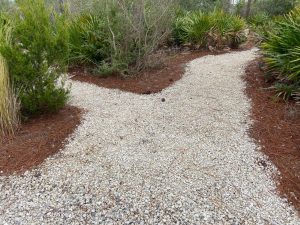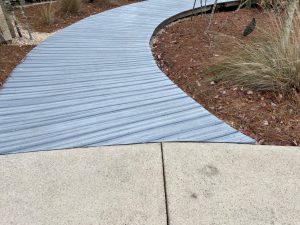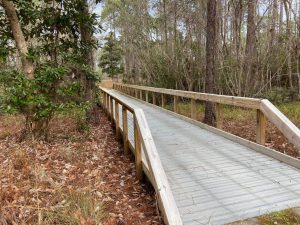There are multiple ways to creatively construct avenues for foot traffic to areas in your landscape, community and public access areas. Over the years I have observed and enjoy many walks that curve and snake around well landscaped corners either created or provided by nature. Paths and trails can provide educational opportunities, recreation, observation points, food collection and water management. 
Designing a path, trail and walkway can happen with the eye and adventurous mind, paper and pencil, by a professional landscaper or landscape architect. Just remember these walkways can be changed and redirected if the environment in which they are set changes. Trails and paths should be determined and installed by the interests and needs at hand. Always remember to plan for who may visit these wonderous settings. Will this be a place for adults, high energy youth, or individuals with disabilities? Access to these areas may be challenging with transitions from walks to bridges, elevation changes, wet areas and others. Clearly determining the purpose of these areas is important and needed. Include others in the conversation and planning for a broader look and understanding to determine the scope of the project.
With past history of marking bike, walk and running trails this is the time of year to walk the area that will become these adventures followed by planning, construction and completion before the hot weather of summer. Identifying and locating features to be included on a plat for these pathways must occur early in the process. Flag plants and strategic areas to save and highlight as a part of roughing out the path. Use signage to direct or educate. Will the walk be on a loop back to the same location or lead to other areas? All of this is a way to lead visitors and yourself to the next best point to enjoy. Jot down notes and pencil a drawing of the area with all of these observed and planned spots. Seasonal changes in the landscape along these paths are important to keep in mind and could include early emergence of flowers, spring leaves on many trees, shrubs and perennials.
Keep in mind some root removal may be needed to properly prepare the pathway subsurface, so be careful where you select a path location to reduce the impact on existing tree roots. Enjoy your gardening adventure of hardscaping!
Your message has been sent
The strenuous part of paths and trails is the construction involving plant removal, pruning and establishing a subsurface material before placing the final layer material to walk, run or bike on. Check for clearing heights that will not create high obstructions for the head by walkers or bikers. Some of this work may require the use of a tractor and rotary implement to till the walk area before placing the base material. Be careful in selecting the appropriate final path material that reduces the chance of slipping on or tripping visitors. Enjoy the journey, as a coworker and friend would always close with.
- Deer Damage in the Landscape - February 22, 2024
- Gardeners: A Critical Link to Protecting Our Water - January 18, 2024
- Propagating Plants by Leaf and Cane - December 14, 2023



